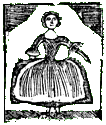The Mysteries of Ezekiel Russell’s Wife
I’ve been writing about printer Ezekiel Russell’s wife, who, according to Isaiah Thomas’s History of Printing, was a great help to him in his business. Indeed, as I quoted yesterday, the first edition of that book said she learned the printing business and wrote memorial verses for broadsides.
Since 2009 I’ve been calling that woman Penelope Russell because that’s what later printing historian Josiah Snow called her in 1847. But over the past few days I’ve realized that her name was Sarah Russell.
That’s clear from a series of documents:
So where did the name Penelope Russell come from? Was she just an error by Snow, repeated by later authors through to me? Or, since Waters linked her to the Censor, published in 1771-72, perhaps she was Russell’s first wife (though I haven’t found any other trace of her). If the latter, that could mean both of Russell’s wives were active in the printing house.
Another question: Bostonians didn’t go up to Hampton, New Hampshire, to be married by a Presbyterian minister unless they were eloping. What was the story behind the Russells’ marriage in 1773? Did they have any children in the mid-1770s? Why did they have four children baptized by a Congregationalist minister at their home in 1787, but not the oldest, Nathaniel Pope Russell? (If there was illness in the family, the baby survived, but I don’t know about the middle children.)
Since 2009 I’ve been calling that woman Penelope Russell because that’s what later printing historian Josiah Snow called her in 1847. But over the past few days I’ve realized that her name was Sarah Russell.
That’s clear from a series of documents:
- The record of the marriage of Ezekiel Russell and Sarah Hood in Hampton, New Hampshire, on 7 Oct 1773.
- Biographies of their oldest (surviving) child, Nathaniel Pope Russell, born in Danvers in 1779.
- The births of two younger children in Boston in 1785 and 1787.
- The baptisms of four younger children at Ezekiel Russell’s house by the minister of the Hollis Street Meetinghouse, all on one day in May 1787.
- Real estate records from Boston in the 1780s and 1790s.
- Ezekiel’s death notice in the 12 Sept 1796 Federal Orrery, and Sarah’s notice for administering his estate in the 7 Oct 1796 Massachusetts Mercury.
- Sarah’s unusual listing as a printer in the 1798 Directory of Boston.
- Sarah’s death notices in the 16 Oct 1806 Boston Gazette and 24 Oct 1806 Farmer’s Museum.
So where did the name Penelope Russell come from? Was she just an error by Snow, repeated by later authors through to me? Or, since Waters linked her to the Censor, published in 1771-72, perhaps she was Russell’s first wife (though I haven’t found any other trace of her). If the latter, that could mean both of Russell’s wives were active in the printing house.
Another question: Bostonians didn’t go up to Hampton, New Hampshire, to be married by a Presbyterian minister unless they were eloping. What was the story behind the Russells’ marriage in 1773? Did they have any children in the mid-1770s? Why did they have four children baptized by a Congregationalist minister at their home in 1787, but not the oldest, Nathaniel Pope Russell? (If there was illness in the family, the baby survived, but I don’t know about the middle children.)

